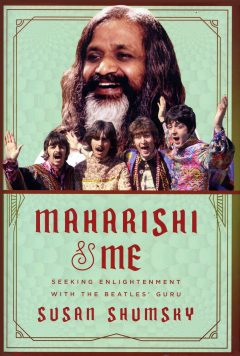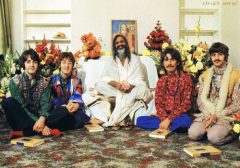Book Reviews
The Reasons Why: The Story of TM, Susan Shumsky, and Four Lads from Liverpool
First things first. Despite the Beatles pictured on the cover, this book isn’t about them. Indeed, it’s not a not a book about music, but fans of both will find it an interesting read. There have been plenty of books written about the Fab Four, even more that feature them in some capacity and you could probably stock a couple of large book stores with them. So does the world need another tome? In this case, I would say yes.
While the Beatles are right up front, the actual premise of the book is right there in the title. Maharishi and Me is the story of Susan Shumsky, a student of the Maharishi Mahesh Yogi (1918—2008), who spent years working with and around him and devoted much of her life to promoting transcendental meditation. While the book is enthusiastically pro TM, that’s not necessarily always the case here with regard to the Maharishi, or at least the organization surrounding him.
At 307 pages, with a full-color photo section, including many photos of the Beatles in India and various indexes, there is a lot of detail here. There are also lots of black-and-white photos scattered throughout the book. Because there were several women named Susan working with the Maharishi at the time, he dubbed her “Susan the Artist” due to her artistic skills–some of the art she did at the time is reproduced here, and it is quite good.
The story really deals with Shumsky’s quest for enlightenment and in the midst of this she explains the Beatles visit to India in 1968. This visit by Lennon, McCartney, Harrison, and Starr was the catalyst to the western world’s interest in Transcendental Meditiation, a crucial time in their development and where much of the White Album was written. She does not claim to have met the Beatles or been at the Ashram at the same time, but she was part of events before and afterward, offering something missing from many other accounts of this Fab Four chapter: context. As a devout follower of the Maharishi, she spells out how the ashram was run, names names, and fills in a lot of detail that goes a long way in explaining both the attraction of the Maharishi to the Beatles and why the situation was likely doomed from the start. Want to know who “Bungalow Bill” was? Who made the allegations that led to the Beatles leaving the Ashram? It’s here in more detail than I’ve ever seen before. It’s important to note that the Beatles did separate themselves from the Maharishi in the late 1960s but continued to practice TM and had positive contact with him through their solo careers.
Shumsky doesn’t candy coat events. Indeed, the latter half of the book shows the Maharishi’s organization becoming paranoid and, frankly, oppressive, and she doesn’t shy away from the various lawsuits and rumors flying around the Maharishi, whether it be occurrences within the Beatles circle or later events surrounding the Maharishi University of Management (MUM). Shumsky is also quite candid about her life, from the free-love hippie era to today’s corporate world of book publishing.
The Maharishi’s teaching style could be emotionally devastating–loving and friendly one moment and dismissive the next. It says a lot about Shumsky’s devotion to the Guru, which she lovingly endured what seemed like test after test as she shuttled around the world to keep up with his teachings and projects. He could be quite harsh as she struggled to show devotion to his teachings. Her insecurity during her time working with the Maharishi rings through loud and clear, making the final chapters when she finds her way quite uplifting.
There are plenty of musician’s in the book. An appendix listing well known folks who have used TM, from Sheryl Crow to Tom Petty is included. John Densmore and Ray Manzerek, pre The Doors, meet at a TM event. The Rolling Stones feature. The Beach Boys–and Mike Love in particular–show up. Donovan is less than friendly to her.
While Shumsky was not in India when the Beatles were there, she does a good job of gathering up in one place all the bits and pieces of info out there, from quotes in books and recordings, complete with footnotes. One of my favorite John Lennon quotes is about Prudence Farrow and her breakdown while at the Ashram, which ends with “…and so we sang to her.” The off-the-cuff remark can be found on the demo of “Dear Prudence,” recorded by the band at George Harrison’s Esher (a London suburb) bungalow in 1968, and it’s to Shumsky’s credit that it’s included here. The fact that the Beatles left under some acrimony is well known; she fills in day-to-day detail and timeline info so we can see how events leading up to the known conclusion moved forward and progressed.
The most fascinating part of the book deals with her time during the 1980s in Fairfield, Iowa, where the Maharishi founded a community. Without revealing too much, this part of the story is particularly interesting as she shifts to clandestine operations. As one of the few there who didn’t toe the organizations line, Shumsky was subjected to intimidation from them, which, while unfortunate for her, makes this part of the story a particularly compelling read.
Rounding out the book, Shumsky offers profiles on various well-known practitioners of TM. Some offer minor info that doesn’t have a lot of relevance to the story, such as the bit on magician Doug Henning. Meanwhile, others, such as the section on Deepak Chopra, gives a a great deal of insight and brings the TM story up to date. One interesting point, though it contradicts facts, Shumsky dutifully lays out earlier in the book, according to Chopra, that the Maharishi kicked the Beatles out of the ashram in India because they were using drugs. This goes against every other report on the subject I have seen.
Do I recommend the book? Yes. It’s not for everybody, but music fans, students of the 1960s, and anyone curious about TM will find useful information as well as an interesting read. While there were only a few tidbits about the Beatles in there that were new to me, this went a long way in explaining the appeal of TM, as well as providing a lot of background. Reading Maharishi and Me made me think about how much the world has changed since the 1960s, not so much in technology but in public opinion, social mores, attitudes, and travel. Not all movement has been forward.
Shumsky does a good job of portraying the many ups and downs of her life en route to enlightenment. I can’t help thinking this would make a pretty good movie.









